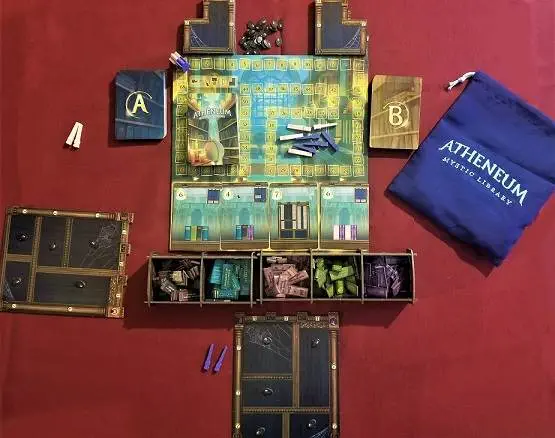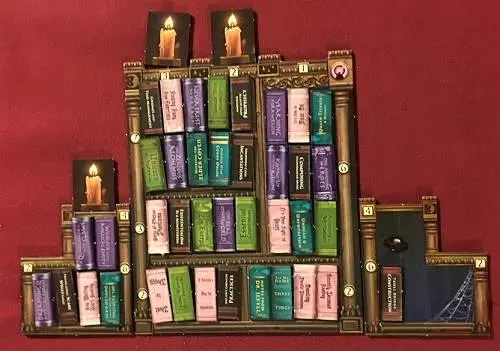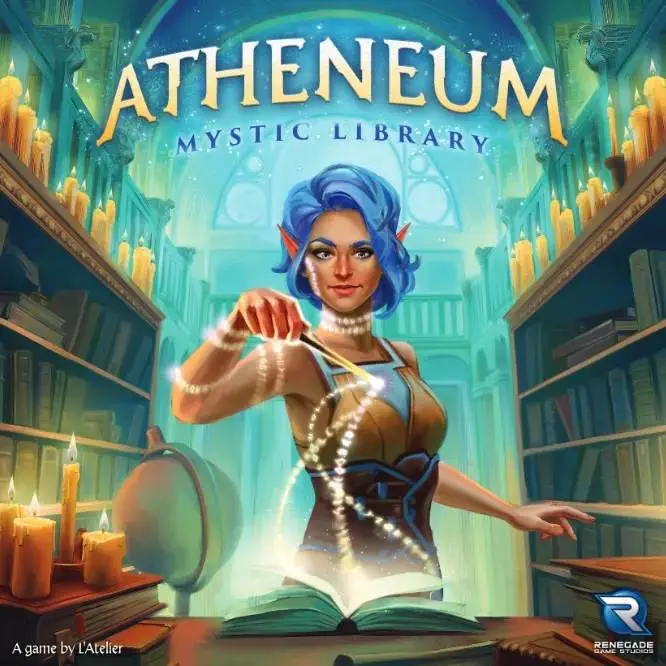You forgot to study for exams and the library is about to close, but luckily the security guard needs a favor! After agreeing to clean up the mystical library in exchange for after-hours access, 2-5 magic students will compete to organize shelves following laid out objectives. Filling complete compartments, clearing out spiders, and lighting the occasional candle will all work towards the goal of having the most points at the game’s end. With a limited amount of turns and cards changing hands each turn, will you be able to organize your section as requested and claim victory over the others?
Atheneum: Mystic Library is a fantasy tile placement game designed by L’Atelier and featuring artwork from Jeanne Torres and Veronika Fedorova. The game was released in the Fall of 2020 by Renegade Game Studios. L’Atelier is probably best known for Obscurio, which was released in 2019 by Libellud. Torres has also worked on several other Renegade Game Studios titles including Pie Town and Junk Orbit. Fedorova’s artwork can also be found in Thunderworx Games’ Roll Player Adventures.

As with most games, the set up for Atheneum: Mystic Library begins by putting the game board in the middle of the play area. The side shelves and spiders are placed near the board in supply piles. All bonus tokens are placed in the draw bag and set aside for later use. There are three decks of cards included in the game: Study Cards “A”, Study Cards “B”, and Objective Cards. These should all be separated out into their respective decks and shuffled. Decks “A” and “B” are placed off to the side with room for a discard pile. The Objective deck is placed on the board and the top four are dealt into the Objective Row. The Book tokens are separated by type/color and placed into their respective spot in the included book bins. Each player then receives a main shelf, student pawn, and set of wands in their chosen color as well as five spider tokens. Players will next put their student pawn on the “0” space on the score track, keep two of their wands and place the other in a supply on the board, and distribute their spider tokens to the empty compartments of their main shelf.

Each game is divided into two phases, “A” and “B,” with their own Study deck. At the beginning of each phase, players are dealt a hand of six cards from the appropriate Study deck. Each player will simultaneously choose a card from their hand that they wish to play for the turn. Once all players have chosen a card, all cards are revealed and players pass their hand of cards to the player on either their left or right as designated on the back of the Study cards (Phase “A” is clockwise and Phase “B” is counterclockwise). Study cards are then resolved in the following manner: the player that played the card gets the benefits from the yellow section, the player to their left gets what is in the green section, and the player to their right gets what is in the blue section. The benefits themselves are resolved in whatever order the player chooses, but it is important to note that any unused benefits (including unshelved books, bonus tokens, and/or re-shelving options) are lost at the end of the turn. After resolving their benefits, players can score objectives by placing a wand onto the corresponding card. Each objective can only be scored once per player, but multiple players can score the same objective. These points are earned immediately. At the end of the round, the rightmost card in the Objective row is discarded and the remaining objectives are moved down before filling the new space with a new objective from the deck. After five rounds, phase “A” ends and each player’s remaining cards are discarded. A whole new hand of six cards is dealt to each player, but this time from the “B” deck. The phase is played the same except player rotation goes in the opposite direction. After ten total rounds, the game ends and everyone’s bookshelves are scored as per the rule book. The player with the most points wins.

There is so much to love about Atheneum: Mystic Library! A lot of thought and care went into designing the game. My favorite has got to be the little book tokens and their titles! Each one is unique and yet really fitting for both an occult library and the category they belong to. For example, there is a book titled Nowhere to Hyde that belongs to the Biographies and Memoirs category. In addition to the individual titles for each book, the game comes with a different shaped Meeple for each student. Atheneum: Mystic Library scales well with well-balanced mechanics. The dynamics, however, change quite drastically based on the number of players. For example, in a two-player game, your opponent is both to your left and your right making each card give the other player multiple benefits. The dynamics also change between phases, which makes utilizing multiple strategies a must. What worked during the “A” phase, probably won’t work during the “B” phase. All of this comes together to create a delightful and well presented family-friendly game that we look forward to playing again soon.
All photos of Renegade Game Studios products were taken and edited by Krista unless otherwise stated. We also want to give a huge shout out to our FLGS Great Escape Games for allowing us to borrow their demo copy for our review.
